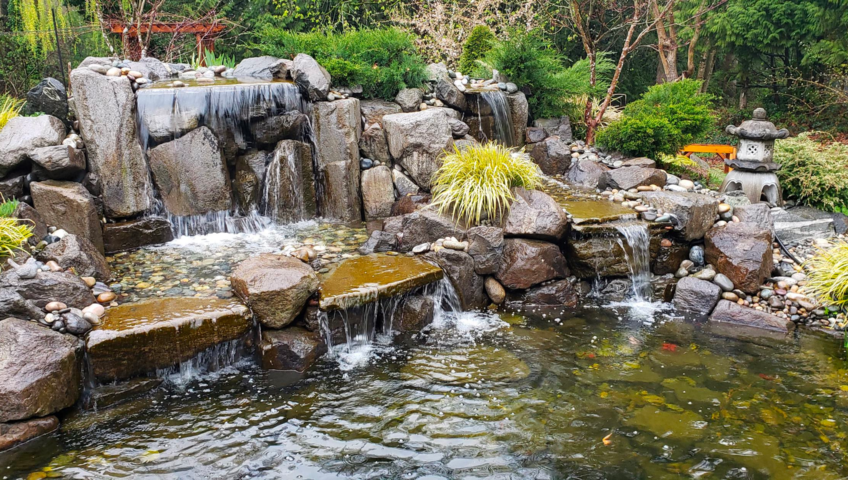Waterscape Maintenance 101: Keeping Ponds and Fountains Pristine
Dive into the serene world of water features and learn how to keep your aquatic havens sparkling all year round! Whether you’re a homeowner with a charming koi pond or a business owner boasting an extraordinary water fountain, this guide to waterscape maintenance is just what you need. Uncovering secrets from the experts at No Limit Landscapes, we delve into helpful tips and invaluable advice that will ensure your ponds and fountains always remain pristine, elevating your outdoor space to impressive new levels. Get ready to explore the art of maintaining waterscapes, because where there’s water, there should be no limit to perfection.
In our article, “Waterscape Maintenance 101: Keeping Water Features Pristine,” we offer expert tips and guidance to help you maintain the beauty and health of your water features. From regular inspections to water quality testing, algae control, and plant care, our comprehensive guide covers the essential steps needed to keep your water feature clean and thriving. We also delve into seasonal maintenance tasks, such as leaf management, fish care, and equipment maintenance, ensuring that you have a year-round plan for optimal water feature upkeep.
Monitoring Water Levels and Cleanliness
Regular maintenance of pond water levels and cleanliness is essential for creating a healthy ecosystem. A drop in water levels could mean a leak or evaporation, which might cause stress for aquatic plants and fish. It’s vital to maintain the right level of water by topping up the pond. However, ensure that you don’t fill the pond above the recommended level since it can affect its oxygenation. Regular cleaning is also necessary where any debris or dirt needs removal from your pond. Mulm, decayed organic matter, and uneaten food could accumulate at the bottom and adversely affect the ecology. Keeping your pond free from decaying leaves, algae, and debris will maintain water quality, which is crucial for plant growth and the health of aquatic creatures like fish. Algae growth in ponds often leads to an imbalance in ecosystems, such as depletion of oxygen levels and poor water quality.
Algae and Pest Control
One of the primary causes of poor water quality is the growth of algae in ponds. Algae are organisms that thrive in warm environments with plenty of sunlight, low oxygen, and high nutrient levels, so keeping your pond clean would help control their growth. The following table highlights different methods with their respective advantages, disadvantages, and effectiveness for managing algae:
| Method | Advantages | Disadvantages | Effectiveness |
| Manual removal | No chemicals are required. | Time-consuming | Limited |
| Biological control | Easy application process | It may take time to work. | Limited |
| Chemical products | Fast results | Must follow instructions carefully. | High |
Another common issue besides algae is pests such as snails or insects invading ponds; this happens when unfiltered tap water or soil contains eggs of these organisms. If left unchecked, pests could cause damage to plants and even lead to the death of fish. It’s essential to prevent pests from invading by ensuring all soil and water added are free from eggs. Make sure to inspect any new plant additions or purchases, and even consider quarantining them first before adding them to the pond. Chemical treatments are available for specific pest control but must be used sparingly since they could potentially harm aquatic plants and fish. For instance, neem oil is an organic solution that can control snail infestations in ponds effectively. Applying it once a week will ensure no snail population growth occurs.
Filtration and Water Quality Maintenance
The key to maintaining the beauty of your waterscapes lies in their filtration and water quality. Filtration systems help remove impurities, such as debris and dirt particles, that can build up and cause poor water conditions. Proper filtration ensures that water remains clear, healthy, odorless, and well-aerated. To achieve this, a careful selection of equipment that suits your waterscape’s size, location, depth, and environmental factors is necessary. Routine water quality maintenance also plays a vital role in enhancing the waterscape’s health. This includes pH level monitoring, chemical treatments for algae or bacteria blooms, regular removal of dead leaves and other organic material, and checking for leaks or damages to pipes or pumps, among other tasks. Establishing a consistent schedule for these tasks will prevent long-term damage to your ponds or fountains.
Handling Equipment: Pumps and Filtration Systems
Handling equipment in waterscape maintenance is vital to ensuring that the ecosystem within remains sustainable. Two significant examples are pumps and filtration systems.
Pumps play an important role in keeping the water circulating continuously through their CPVC piping systems. They ensure proper balance within the waterscape by re-oxygenating the water while decreasing harmful nutrient levels. When considering pumps for your pond or fountain landscape, factors such as pump height, flow rate capacity, size of pumping chamber (in relation to volume), and total head resistance must be taken into account.
Similarly, a suitable filtration system aids in maintaining optimal water quality by regularly cleaning out unavoidable debris from your pond or fountain. The different types of systems offer varying degrees of cleaning capacities: mechanical filtration offers primary debris removers, while biological filtrations neutralize pathogens found lurking in the depths of your waterscape.
Debating which form best suits your pond or fountain requires careful consideration of its proximity to vegetative cover, size, and depth. It is also crucial to consider energy consumption and required maintenance costs before installation. Choosing a filtration system is similar to investing in a good pair of shoes—you need something that fits your unique needs, provides comfort and durability, and enhances (rather than constricts) your movements.
Choosing Suitable Equipment for Your Waterscapes
Waterscaping is often an intricate and delicate process, necessitating the use of suitable equipment and tools to establish a serene and thriving aquatic environment. Factors you need to consider while choosing the right tools include your budget, pond or fountain size, water quality, and personal preference. It’s advisable to start with basic maintenance gear such as nets, skimmers, vacuum cleaners, aerators, and filters. These will help keep your waterscape clean, promote healthy aquatic life, and eliminate algae growth. Essential safety gear should also be part of your toolkit to ensure safe operation when cleaning ponds or handling fountain parts.
Seasonal Waterscape Maintenance Guide for Ponds and Fountains
Regular maintenance is key to ensuring pristine water quality in your ponds or fountains throughout the year. Ideally, you should have a schedule for seasonal care that involves regular inspection of equipment faults as well as debris management.
- Springtime: This season marks the time to prepare your waterscapes for warmer weather. Take stock of any damage due to winter colds, such as broken pipes or frozen pumps, that might require repair or replacement. Use this period as an opportunity to install new upgrades on equipment that can enhance performance during hotter weather.
- Summer: This is a high season for maintaining the health of your waterscape against microbial attacks like bacteria or algae blooms. Begin by adding biological treatments in the early part of summer, as they will work best ahead of the sweltering heat. You can then check that your filter system is running at its optimal capacity while observing animal life in and around the pond or fountain.
- Fall: In the fall, seasonal changes bring a significant drop in temperature, which leads animals like fish into hibernation mode. This time presents an excellent opportunity to deep clean your pond or fountain thoroughly. You should remove most of the debris and muck in your water features using vacuums, filters, and skimmers.
- Winter: This season is usually when everything slows down and your aquatic life prepares for dormancy. It’s crucial to protect your waterscape from harsh winter weather by installing pumps designed to withstand low temperatures or by shutting down systems until springtime.
With a seasonal maintenance guide now at your fingertips, let’s explore ways to manage debris and eliminate clogging effectively.
Debris Management and Clogging Solutions
Debris management and clogging solutions are two of the most critical aspects of managing waterscapes. Leaves, twigs, dead algae, and other organic materials can accumulate inside a pond or fountain over time, leading to clogging and reduced water flow. Neglecting this aspect of maintenance can result in unpleasant odors, imbalanced water quality, and even severe damage to aquatic plants and wildlife.
| Types of debris | Recommended Solution |
| Leaves and twigs | Use a skimmer net or rake to manually remove the debris daily or weekly. |
| Dead algae and other organic substances | Install a pond vacuum or use a garden hose attachment with pressurized water jets to clean the bottom of the pond every few weeks. |
| Fish Waste | Use a biological filtration system that introduces beneficial bacteria into the water column to digest waste material. |
It’s essential to understand that different kinds of debris present varying degrees of challenges. Leaves and twigs require simple manual removal using rakes or skimmer nets at regular intervals. However, dead algae or other organic substances can be trickier since they tend to settle at the bottom of ponds and fountains, making it harder to remove them using manual methods. Installing a reliable pond vacuum or using a garden hose with pressurized water jets can be more effective.
As fish waste can release ammonia and reduce oxygen levels, it’s crucial to manage it properly through biological filtration systems. These filters introduce beneficial bacteria into the water column that feed on fish waste material and convert it into less harmful byproducts.
In conclusion, debris management is an integral part of maintaining healthy and aesthetically pleasing waterscapes. By using the appropriate equipment and solutions, pond owners can keep their fountains or ponds clog-free while supporting aquatic life. Remember to establish regular maintenance schedules with set intervals for effective debris management.
Keeping Ponds and Fountains Pristine
Ready to transform your outdoor oasis into a serene sanctuary? Let No Limit Landscaping be your partner in keeping your waterscapes sparkling clean and endlessly inviting. Dial 604-559-9882 today and dive into hassle-free maintenance for your ponds and fountains. Say goodbye to worries and hello to tranquility, because with us, there’s no limit to the beauty we can create together!


